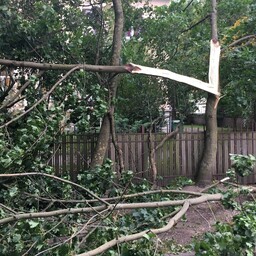Sel aastal on päästeamet eemaldanud veidi üle tuhande ohtliku puu. See on palju rohkem kui eelmisel aastal. Näiteks Tartumaal kutsuti päästeametit puid eemaldama 155 korda mullu, aga sellel aastal oli juba 255 korda.
Päästeameti ametnik Tarmo Voltein ütles, et üle Eesti on sündmuste arv suurenenud. Juuli esimestel nädalatel pidi päästeamet eemaldama pea kolm korda rohkem puid kui eelmisel aastal.
Tormi ajal reageerivad tihti ka
vabatahtlikud komandod
. Päästeamet jõuab kohale keskmiselt 13 minutiga. Tavaliselt on puu eemaldamiseks vaja
raieluba
, aga
erandkorras
võib seda teha ka ise.
vabatahtlikud komandod
Tõlge fraasile: vabatahtlikud komandod
EN
volunteer teams
raieluba
Tõlge fraasile: raieluba
EN
logging permit
erandkorras
Tõlge fraasile: erandkorras
EN
in exceptional cases
Tartu linna arborist Kaire Zimmer rääkis, et kui puu on tormis murdunud, tuleks sellest teada anda linnale. See aitab dokumenteerida, et puu oli ohtlik ja seda sai eemaldata raieloata.
Reeglina eemaldab päästeamet inimesele või asjadele ohtlikud puud. Teele langenud puudega tegelevad tavaliselt teehooldajad.
Voltein julgustas inimesi
helistama päästeametisse
, kui nad näevad ohtlikku puud. Vaja on helistada, kui on oht inimestele, loomadele või varale.
helistama päästeametisse
Tõlge fraasile: helistama päästeametisse
EN
call the rescue service
Selle suve tormid on olnud tugevamad kui eelmisel aastal. Ilmateadlane Taimi Paljak ütles, et tänavu on sademeid rohkem ja õhk on jahedam. Niiske maapind ei hoia puid nii hästi kinni, mistõttu nad tugeva tuulega murduvad.
Tugev tuul ja äikesed on suurendanud puude langemist. Näiteks 3.-4. juuli torm oli erakordselt tugev. Äikesepilvede all võib tuul olla kuni 26 meetrit sekundis.
This year, the rescue service has removed slightly over a thousand dangerous trees. This is much more than last year. For example, in Tartu County, the rescue service was called to remove trees 155 times last year, but this year it has already been 255 times.
Tarmo Voltein, an official of the rescue service, said that the number of incidents has increased across Estonia. In the first weeks of July, the rescue service had to remove almost three times as many trees as last year.
During storms, volunteer teams often also respond. The rescue service arrives on-site within an average of 13 minutes. Usually, a felling permit is required to remove a tree, but in exceptional cases, it can also be done by oneself.
Kaire Zimmer, an arborist from the city of Tartu, said that if a tree has been broken in a storm, it should be reported to the city. This helps to document that the tree was dangerous and could be removed without a felling permit.
As a rule, the rescue service removes trees that are dangerous to people or property. Trees that have fallen on roads are usually handled by road maintenance crews.
Voltein encouraged people to call the rescue service if they see a dangerous tree. It is necessary to call if there is a danger to people, animals, or property.
The storms this summer have been stronger than last year. Meteorologist Taimi Paljak said that this year there has been more rainfall and the air is cooler. Wet ground does not hold trees as securely, which is why they break in strong winds.
Strong winds and thunderstorms have increased tree falls. For example, the storm on July 3-4 was exceptionally strong. Under thunderclouds, the wind can reach up to 26 meters per second.

